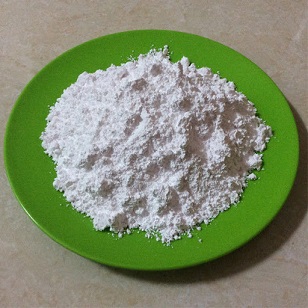| Uses | Beryllium oxide (BeO) is a beryllium compound produced in significant commercial quantities.
The chemical process starts with minerals containing aluminum silicate and silicon
dioxide and undergoes a number of chemical reactions, some at high temperatures, to end
up with BeO. |
| Description | Beryllium oxide
(BeO) is formed by the ignition of beryllium metal in an oxygen atmosphere. The resulting solid is colourless
and insoluble in water. |
| Physical properties | Beryllium oxide (BeO) is a white crystalline oxide. It occurs in nature as the mineral “Bromellite”. Historically, beryllium oxide was called glucina or glucinium oxide. It is an electrical insulator and its thermal conductivity is such that it is higher than any other nonmetal except diamond, and actually exceeds that of some metals. Its high melting point leads to its use as a refractory.

|
| Uses | Beryllium oxide is used in the manufacture of high-temperature refractory material and high-quality electrical porcelains, such as aircraft spark plugs and ultrahigh-frequency radar insulators. The high thermal conductivity of beryllium oxide and its good high- frequency electrical insulating properties find application in electrical and electronic fields.
Another use of beryllium oxide is as a slurry for coating graphite crucibles to insulate the graphite and to avoid contamination of melted alloys with carbon. Beryllium oxide crucibles are used where exceptionally high-purity or reactive metals are being melted. In the field of beryllium oxide ceramics, a type of beryllia has been developed that can be formed into custom shapes for electronic and microelectronic circuits. Beryllium oxide has a high thermal conductivity, equal to that of aluminum, and excellent insulating properties, which permits closer packing of semiconductor functions in silicon integrated circuits. |
| Uses | Beryllium oxide is used in many high-performance
semiconductor parts for applications such as radio
equipment because of its good thermal conductivity
while also being a good electrical insulator. It is used
as a filler in some thermal interface materials such as
“THERMAL GREASE”.Some high-powered semiconductor
devices have used beryllium oxide ceramic
between the silicon chip and the metal mounting base
of the package in order to achieve a higher degree of
thermal conductivity than for a similar construction
made with Al2O3. It is also used as a structural ceramic
for high-performance microwave devices, vacuum
tubes, magnetrons and gas lasers.
Beryllium oxide (BeO) is a space age technical
ceramic material that offers a combination of desirable
properties not found in any other material. |
| Uses | Beryllium oxide?is widely used in industry due to its low density and high thermal and electrical conductivity. It is used in high-technology ceramics, electronic heat sinks, electrical insulators, high-power devices, high-density electrical circuits, microwaves, X-ray windows, nuclear reactor fuels and for various aerospace and military applications. |
| Definition | ChEBI: A beryllium molecular entity consisting of beryllium (+2 oxidation state) and oxide in the ratio 1:1. In the solid state, BeO adopts the hexagonal wurtzite structure form while in the vapour phase, it is present as discrete diatomic covalent molecules. |
| Preparation | Beryllium oxide can be prepared by calcining beryllium carbonate, dehydrating the hydroxide or igniting the metal with oxygen gas, as shown in the following reactions:
BeCO3→BeO+CO2
Be(OH)2→BeO+H2O
2Be+O2→2BeO
Igniting beryllium in air |
| General Description | Odorless white solid. Sinks in water. |
| Air & Water Reactions | The amount of heat generated by hydrolysis may be large. |
| Reactivity Profile | BERYLLIUM OXIDE is incompatible with the following: Acids, caustics, chlorinated hydrocarbons, oxidizers, molten lithium, magnesium . |
| Hazard | Highly toxic by inhalation. Keep container
tightly closed and flush out after use.
|
| Health Hazard | Any dramatic, unexplained weight loss should be considered as possible first indication of beryllium disease. Other symptoms include anorexia, fatigue, weakness, malaise. Inhalation causes pneumonitis, nasopharyngitis, tracheobronchitis, dyspnea, chronic cough. Contact with dust causes conjunctival inflammation of eyes and irritation of skin. |
| Fire Hazard | Special Hazards of Combustion Products: Toxic BERYLLIUM OXIDE fume may form in fire. |
| Industrial uses | A colorless to white crystalline powder of the composition beryllium oxide, also called beryllia. It has a specific gravity of 3.025, a high melting point, about 2585 C, and a Knoop hardness of 2000. It is used for polishing hard metals and for making hot-pressed ceramic parts. Its high heat resistance and thermal conductivity make it useful for crucibles, and its high dielectric strength makes it suitable for high-frequency insulators. Single-crystal beryllia fibers, or whiskers, have a tensile strength above 6800 MPa.
Beryllium oxide is tapped for nuclear reactor service because of its refractoriness, high thermal conductivity, and ability to moderate (slow down) fast neutrons. The thermal neutrons that result are more efficient in causing fusion of uranium- 235. Nuclear industry uses for beryllia include reflectors and the matrix material for fuel elements. When mixed with suitable nuclear poisons, beryllium oxide may be a new candidate for shielding and control rod assembly applications. |
| Safety Profile | Confirmed carcinogen withexperimental tumorigenic data. Experimental teratogenicdata. Other experimental reproductive effects. Incompatible with (Mg +heat). When heated to decomposition it emits very toxicfumes of BeO. |